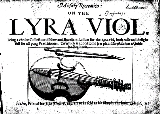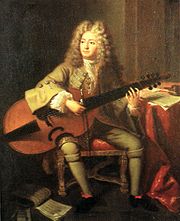
Lyra viol
Encyclopedia

Viol
The viol is any one of a family of bowed, fretted and stringed musical instruments developed in the mid-late 15th century and used primarily in the Renaissance and Baroque periods. The family is related to and descends primarily from the Renaissance vihuela, a plucked instrument that preceded the...
, used primarily in England
England
England is a country that is part of the United Kingdom. It shares land borders with Scotland to the north and Wales to the west; the Irish Sea is to the north west, the Celtic Sea to the south west, with the North Sea to the east and the English Channel to the south separating it from continental...
in the seventeenth century.
While the instrument itself differs little physically from the standard consort
Consort of instruments
A consort of instruments was a phrase used in England during the sixteenth and seventeenth centuries to indicate an instrumental ensemble. These could be of the same or a variety of instruments. Consort music enjoyed considerable popularity at court and in households of the wealthy in the...
viol, there is a large and important repertoire which was developed specifically for the lyra viol. Due to the number of strings and their rather flat layout, the lyra viol can approximate polyphonic textures, and because of its small size and large range, it is more suited to intricate and quick melodic lines than the larger types of bass viol.
The lyra viol has been favorably compared to both the lute
Lute
Lute can refer generally to any plucked string instrument with a neck and a deep round back, or more specifically to an instrument from the family of European lutes....
and the violin
Violin
The violin is a string instrument, usually with four strings tuned in perfect fifths. It is the smallest, highest-pitched member of the violin family of string instruments, which includes the viola and cello....
, by Tobias Hume
Tobias Hume
Tobias Hume was a Scottish composer, viol player and soldier.Little is known of his life. Some have suggested that he was born in 1569 because he was admitted to the London Charterhouse in 1629, a pre-requisite to which was being at least 60 years old, though there is no certainty over this...
and Roger North
Roger North (17th century)
Roger North, KC , English lawyer, biographer, and amateur musician, was the sixth son of t he fourth Baron North....
respectively. The name lyra viol came into use because the playing style of bowed chord
Chord (music)
A chord in music is any harmonic set of two–three or more notes that is heard as if sounding simultaneously. These need not actually be played together: arpeggios and broken chords may for many practical and theoretical purposes be understood as chords...
s is similar to that of the lirone
Lirone
The lirone, the bass member of the lira family of instruments, is a bowed string instrument with between 9 and 16 gut strings. It is held between the legs in the manner of a cello or viol and like the viol its neck is generally fretted...
.
Structure
The structure of the lyra viol has been fluid throughout its history. In seventeenth century England sympathetic strings were added. This may have led to the development of the barytonBaryton
The baryton is a bowed string instrument in the viol family, in regular use in Europe up until the end of the 18th century. In London a performance at Marylebone Gardens was announced in 1744, when Mr Ferrand was to perform on "the Pariton, an instrument never played on in publick before." It most...
, but it was not a lasting development for the lyra viol. The most common lyra viols had six strings, but there were also viols with four and seven strings. John Playford
John Playford
John Playford was a London bookseller, publisher, minor composer, and member of the Stationers' Company, who published books on music theory, instruction books for several instruments, and psalters with tunes for singing in churches...
describes the lyra viol as the smallest of three types of bass viol: the consort bass, division viol
Division viol
The division viol is an English type of bass viol, which was originally popular in the mid-17th century, but is currently experiencing a renaissance of its own due to the movement for historically informed performance...
, and lyra viol. Christopher Simpson
Christopher Simpson
Christopher Simpson was an English musician and composer, particularly associated with music for the viola da gamba.-Life:Simpson was born between 1602 and 1606, probably at Egton, Yorkshire...
wrote that the strings on the lyra viol were lighter and the bridge flatter than those on the other bass viols. The strings were also closer to the fingerboard
Fingerboard
The fingerboard is a part of most stringed instruments. It is a thin, long strip of material, usually wood, that is laminated to the front of the neck of an instrument and above which the strings run...
than they were on the consort bass. These modifications were probably in part to make playing chords
Chord (music)
A chord in music is any harmonic set of two–three or more notes that is heard as if sounding simultaneously. These need not actually be played together: arpeggios and broken chords may for many practical and theoretical purposes be understood as chords...
easier. The first description of bowed polyphonic music for the viol is in a treatise by Johannes Tinctoris
Johannes Tinctoris
Johannes Tinctoris was a Flemish composer and music theorist of the Renaissance. He is known to have studied in Orléans, and to have been master of the choir there; he also may have been director of choirboys at Chartres...
, and the first development of its repertoire can be traced back to Sylvestro di Ganassi dal Fontego in the mid-sixteenth century.
Despite these differences in structure, the lyra viol is not significantly different from other bass viols, and lyra viol music can be played on any bass viol.
Repertoire

John Cooper (composer)
John Cooper , also known as Giovanni Coprario or Coperario, was an English composer, viol player and lutenist....
, John Jenkins
John Jenkins (composer)
John Jenkins , English composer, was born in Maidstone, Kent, and died at Kimberley, Norfolk.Little is known of his early life. The son of Henry Jenkins, a carpenter who occasionally made musical instruments, he may have been the "Jack Jenkins" employed in the household of Anne, Countess of Warwick...
, Christopher Simpson
Christopher Simpson
Christopher Simpson was an English musician and composer, particularly associated with music for the viola da gamba.-Life:Simpson was born between 1602 and 1606, probably at Egton, Yorkshire...
, Charles Coleman, and William Lawes
William Lawes
William Lawes was an English composer and musician.-Life and career:Lawes was born in Salisbury, Wiltshire and was baptised on 1 May 1602...
. The types of pieces written for the instrument range from single melodic lines, to lyra trios and duets, lyra with other instruments, and lyra as accompaniment for a song. Almost all music for the lyra viol is written in tablature
Tablature
Tablature is a form of musical notation indicating instrument fingering rather than musical pitches....
, mainly French lute tablature, but also some Italian and a little bit of German lute tablature.
Polyphonic music is idiomatic for the lyra viol. It is most similar to lute music, as the number of voices can change within a piece, unlike harpsichord music where the number of voices tends to stay consistent. Since the lyra viol is bowed, all chords must be formed using adjacent strings. This leads to very close harmonic voice leading
Voice leading
In musical composition, voice leading is the term used to refer to a decision-making consideration when arranging voices , namely, how each voice should move in advancing from each chord to the next.- Details :...
, which may also be the reason for the frequent unison double stops in lyra viol music, perhaps also intended to imitate the double course of strings on the lute. Since all the chords must be formed using adjacent strings, scordatura
Scordatura
A scordatura , also called cross-tuning, is an alternative tuning used for the open strings of a string instrument, in which the notes indicated in the score would represent the finger position as if played in regular tuning, while the actual pitch is altered...
tunings are the rule rather than the exception. Almost 60 different tunings from the seventeenth century have been found. They tended to be formulated so as to put the most important notes on open strings, and were composed in sets of pieces, so that players would not have to retune too frequently.
Another technique for the lyra viol was the ornament
Ornament (music)
In music, ornaments or embellishments are musical flourishes that are not necessary to carry the overall line of the melody , but serve instead to decorate or "ornament" that line. Many ornaments are performed as "fast notes" around a central note...
or grace known as the "thump", where the player plucks the open strings with the fingers of the left hand. This may have been the forerunner of the technique of plucking the sympathetic strings on the baryton. The viol may also have sometimes been held in the lap and played lute-style. The first reference to this practice is in Tobias Hume's The First Part of Ayres (1605), which was written a number of years before Claudio Monteverdi
Claudio Monteverdi
Claudio Giovanni Antonio Monteverdi – 29 November 1643) was an Italian composer, gambist, and singer.Monteverdi's work, often regarded as revolutionary, marked the transition from the Renaissance style of music to that of the Baroque period. He developed two individual styles of composition – the...
's Combattimento di Tancredi e Clorinda (1624) which is frequently cited as the earliest source of pizzicato
Pizzicato
Pizzicato is a playing technique that involves plucking the strings of a string instrument. The exact technique varies somewhat depending on the type of stringed instrument....
. Hume's work also discusses playing col legno
Col legno
In music for bowed string instruments, col legno, or more precisely col legno battuto , is an instruction to strike the string with the stick of the bow, rather than by drawing the hair of the bow across the strings. This results in a quiet but eerie percussive sound.Col legno is used in the final...
on the lyra viol.

